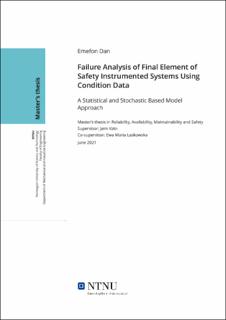| dc.description.abstract | Safety instrumented systems are important independent protection layers used to protect against hazards and accidents associated with hazardous processes and to mitigate their consequences to humans, machines and the environment. They generally consists of three sub components: the sensors, the logic solvers and the final elements. It is important that these systems can carry out their intended function when required. The shutdown valve is one of the most common final element of the safety instrumented system used in the oil and gas and process industries. They may be part of the process control system responsible for keeping the process parameters within set limits or the process shutdown system responsible for isolating a particular section of the plant or the emergency shutdown system responsible for shutting down the whole plant. These systems operate in the so called low demand mode of operation, that is, demand for the activation of the system is no more than once per year. This implies that the system remains in an idle position for long periods of time until there is a demand. While in an idle position, failures may occur which could prevent the system from carrying out its intended function when the need arises. This failure remains hidden until a demand occurs and the system is activated. To detect hidden failures, the system is regularly tested. Proposing an optimal test interval is no easy task. Cost and safety must be balanced. Too frequent testing may be too expensive and may induce stress to the system speeding up the degradation of the valve. Too long interval between test may increase the risk of the system failing before the next test.
In this thesis, the aim is to analyze condition data collected from different valves and use this data to fit a degradation model for the valves to understand how the valves degrade. This understanding can be used to support decision making in maintenance planning and developing optimal testing strategy. The travel time of the valve is an important parameter that describes the condition of the valve. It is required that the valve can close within a given number of seconds less than the time required to achieve process safety. Longer travel time than what is normal can give an indication of an underlying problems. The linear regression model is used to build a predictive model that predicts the next travel time of the valve based on certain factors that are identified to have effects on the travel time such as the time since last activation or maintenance, the travel time during the last activation and the state of the valve at the last activation. The linear model is then used to standardize degradation paths for the valves and degradation models are fit to the path. The Wiener process and the Gamma process with noise are the chosen models to model the degradation of the valves. The Wiener process is a suitable model for modelling non-monotone increasing degradation. The Gamma process on the hand is popular for modelling monotone increasing degradation. To apply the Gamma process to the modelling, it is assumed that the true degradation is monotone increasing and the non-monotonicity observed in the data is due to error in measurements and white noises. Parameters for the models are estimated from the data and the results are presented and discussed. | |
